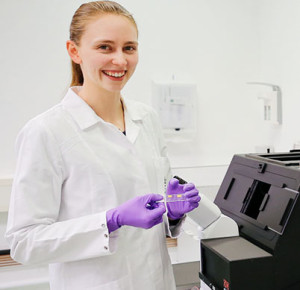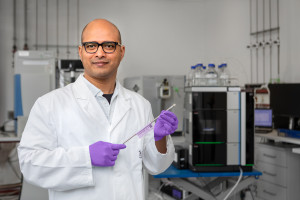Dortmund, 21st October 2022
How can a substance that is neurotoxic, i.e. has a damaging effect on the nerves, possibly play a positive role in the treatment of patients with Alzheimer’s disease? Hydrogen sulfide is the name of the chemical compound we are talking about here. Chemical formula: H2S. This is the gas that makes rotten eggs stink and is released by digested sludge.
The effects of sulfur-containing compounds on the human body are by no means harmful per se; some are even indispensable. Cysteine and methionine, two amino acids, serve as an example of this; the human body can only partially synthesise the former and cannot synthesise the latter at all. As amino acids, they are components of countless proteins. And with their sulfur atom, they are involved in other central metabolic processes whose importance for living cells has only recently become a subject of research.
Gasotransmitters – small molecules with a great impact
Hydrogen sulfide, for example, belongs to a group of gaseous compounds that can transmit signals within and between cells. In addition to H2S, these »gasotransmitters« include carbon monoxide (CO), nitrogen oxide (NO) and nitrous oxide (N2O) among others. The small inorganic molecules are endogenously produced through enzymatic processes in all organisms, and their production is regulated according to their physiological concentration and function. It is believed that this type of cellular communication originated very early in the phylogeny of living organisms.
Research results from previous years have highlighted the importance of gasotransmitters and their involvement in many regulatory processes; however, the specific functions they assume and to what extent they can generally take effect in cells and tissues is still unexplored in many cases. In the case of hydrogen sulfide, however, our scientific understanding has already advanced further, and the involvement of this gasotransmitter in a number of physiological and pathological processes has been proven in numerous studies – not least by the work of Dr habil. Miloš Filipović at ISAS.
“Evolutionary conservation offers potential protection against oxidative stress”
Filipović’s research group in Dortmund is looking for answers to the question of the extent to which H2S-mediated signals are involved in ageing processes. “In combination with the ERC funding, the multi-omics analysis established here at ISAS gives us the opportunity to conduct a detailed investigation into the role of hydrogen sulfide in normal brain function and its impairment such as in Alzheimer’s disease,” explains Filipović.
The term sulfaging is an amalgamation of two words, sulfur and ageing, both representing a focal point of the ERC grant. They also indirectly hint to the type of reaction in which the amino acid cysteine plays a central role. The cysteine molecule contains two functional groups, an amino group (NH2) and a thiol group (SH). Hydrogen sulfide is synthesised in the cells from L-cysteine by three enzymes: cystathionine gamma lyase (CSE), cysthationine beta synthase (CBE) and mercaptopyruvate sulfur transferase (MPST). All three are detectable in various types of tissues and in organs, including the brain.

Dr habil. Miloš Filipović’s research on metabolic biochemistry provides important insights in order to improve for example the diagnosis and treatment of age-related diseases.
© ISAS
The released H2S readily and rapidly combines with the sulfur-containing thiol groups of amino acids in proteins from the environment. This leads to a conformational change of the protein molecules and is accompanied by an alteration of the biological activity. The post-translational modification of proteins induced by a transfer of a sulfur atom is known as sulfhydration or persulfidation. Persulfidated cysteines are more resilient to the oxidative damage. This basic regulatory principle is widely disseminated throughout all cells. “We think this is an evolutionarily conserved way of protecting against oxidative stress,” the biochemist says.
H2S affects brain function
This assumption is also supported by the influence of H2S on several essential physiological functions and processes in the body, such as blood pressure, the immune system, ageing processes and signal transmission in the brain. This can be demonstrated by disturbances in the normal processes of this regulation. In 2021, for example, the research group succeeded in identifying irregular protein persulfidation and H2S metabolism as a hallmark of neurodegenerative diseases such as Parkinson’s disease and Huntington’s disease. During the course of these diseases, nerve cells in the brain gradually die for various reasons. Ageing processes and neuronal degradation are also accompanied by decreased persulfidation and cysteine synthesis.
Alzheimer’s is by far the most common form of dementia and inevitably leads to massive memory loss, speech problems, severe limitations in motor and mental performance, and premature death. It has now been proven that protein persulfidation plays a central role in neurons, but this effect is weakened in Alzheimer’s disease. The corresponding publication, in which Filipović’s team took part, appeared in Proceedings of the National Academy of Sciences of the USA (PNAS) 2021. Typical pathological changes in Alzheimer’s disease are the extracellular deposition of amyloid plaques and neurofibrils (neurofibrillary tangles, NFTs), which form larger filaments in a helical structure (NFTs) in the cytoplasm of neurons. The central component of NFTs is the τ or tau protein. It regulates the stability of microtubules in cells and is therefore essential for the development and stability of the cytoskeleton. In patients with Alzheimer’s disease, on the other hand, the tau protein is altered by a mutation. As a result, it is insoluble, abnormally phosphorylated, and no longer able to bind to microtobules.
Article Recommendation:
Giovinazzo D, Bursac B, Sbodio JI, Nalluru S, Vignane T, Snowman AM, Albacarys LM, Sedlak TW, Torregrossa R, Whiteman M, Filipović MR, Snyder SH, Paul BD. Hydrogen sulfide is neuroprotective in Alzmeimer’s disease by sulfhydrating GSK3ß and inhibiting hyperphosphorylation. Proceedings of the National Academy of Sciences of the USA, Vol. 118, Nr. 4. https://doi.org/10.1073/pnas.2017225118
Impaired signal transmission in Alzheimer’s disease
In their PNAS publication, the authors demonstrate that the regulation of H2S metabolism and the associated signal transmission via persulfidation is impaired in age-related diseases such as Alzheimer’s. In healthy neurons, the tau protein interacts with CSE and stimulates the enzyme to produce more H2S. This, in turn, inhibits another enzyme, glycogen synthase kinase-3β (GSK3β), which is primarily responsible for the regulation of tau phosphorylation. Studies with a CSE mutant and an Alzheimer’s mouse model support this finding: The measurably decreased CSE activity in the brain leads to increased kinase activity, a higher degree of tau phosphorylation, and a stronger aggregation of neurofibrils. The brains of deceased patients with Alzheimer’s disease also exhibit significantly lower levels of CSE than those of individuals who are free of Alzheimer’s disease.

What is persulfidation?
As humans age, the proteins in their cells oxidise. The reason for this is their contact with hydrogen peroxide, a waste product in human metabolism. This is where hydrogen sulfide comes into play and protects the proteins from this very oxidation. This chemical reaction is called persulfidation. In order to slow down ageing processes in the future or to stop age-related diseases such as Alzheimer’s or Parkinson’s disease, Filipović’s team is deciphering, among other things, the mechanisms of hydrogen sulfide actions in the cells. In their analyses of persulfidation, the researchers are supported by nematodes. Caenorhabditis elegans, a worm just one millimetre long that is popular in ageing research, also plays a major role in Filipović’s laboratories.
Less calories, but more CSE & persulfidation
So, could the enzyme CSE or higher H2S concentrations serve as a tuning instrument for slowing down, if not arresting, ageing processes in the brain? “After all, in experiments with Alzheimer’s mice, we were able to increase mental abilities when we supplied H2S from the outside through a donor,” Filipović sums up. Meanwhile, he says, there are not yet any drugs that can increase CSE activity. However, the biochemist knows of several pharmaceutical companies working on developing such compounds. But this could possibly be achieved in a much easier way: through a reduced calorie intake, i.e. a lower food intake. Filipović: “We have already shown in a previous study that fewer calories result in more CSE and persulfidation.” (Zivanovic et al., Cell Metabolism, 2019) In studies with various animal models, this has resulted in life extension.
(Dr. Thomas Krämer)
This project has received funding from the European Research Council (ERC) under the European Union’s Horizon 2020 research and innovation programme (grant agreement No. 864921).









